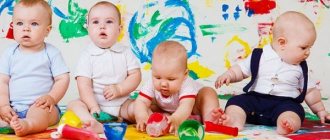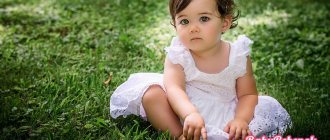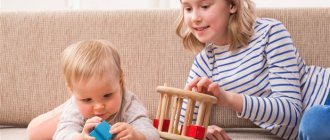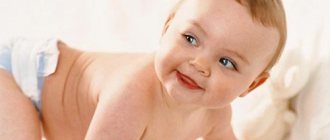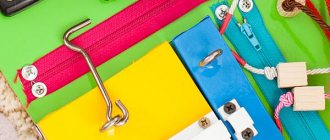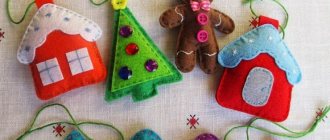General characteristics of child development
For complete and comprehensive development, you need to know what is normal for a 3-month-old child, what skills are considered desirable and mandatory at this age. When comparing the progress of their child with the indicators of physical and mental development of the average baby, parents should remember that all children are different. Each child is unique, so each case is considered individually. A serious lag behind the norm is a reason to consult with a specialist, primarily a local pediatrician or local nurse.
| Skills | Mandatory | Desirable |
| The baby confidently holds his head while lying on his stomach and leaning on his forearms. | + | |
| Examines and sucks hands, finds one hand with the other | + | |
| Turns (rolls) to one side | + | |
| Grabs and holds a toy in his hand | + | |
| Can independently roll over from stomach to back and from back to stomach | + | |
| Recognizes mother and other loved ones | + | |
| Responses to loud sounds, speech and bright lights and easily finds their sources | + | |
| Tracks moving objects | + | |
| Babbles, “talks” | + | |
| Smiling | + | |
| Laughs out loud | + |
Any child will sooner or later master all these skills. The main task of parents is to help the child do this on time, in accordance with age standards or even ahead of them.
Mandatory components of full mental and physical development are: proper nutrition, adequate sleep and walks in the fresh air. By 3 months, it is advisable to establish a daily routine and stick to it. Parents need to pay attention to the predominance of one of the types of wakefulness, morning or evening - lark or owl. Considering this feature of the baby, it is easier to find the right time for classes, massage, swimming and other things.
What to do with a 3 month old baby?
Three months have flown by unnoticed since the birth of your child. Mom overcame fatigue to some extent and recovered after giving birth. The baby is already looking with serious eyes, his inquisitive mind is looking for something interesting around. And everything is interesting all around, without exception. But first things first.
By three months, the baby has usually already developed a certain daily routine, which, of course, will change several times, but for now it gives the mother the opportunity to plan.
Waking up happens differently for all babies. There are sleepyheads who like to sleep until 8–9 am, and there are little ones who are alert and cheerful already at 6 am. An exemplary baby and his correct mother wake up together. Their morning begins with the usual procedures. First, we change the diaper, after washing the bottom with warm water and treating the perineum with powder or baby oil. We change clothes, breastfeed or feed from a bottle with formula. Then we start washing. Using cotton pads soaked in boiled water, lightly wipe the eyes, cheeks, forehead, chin and ears. We twist a wick from cotton wool, soak it in a weak saline solution and treat both nasal passages to soften and remove mucus and crusts. Here is a clean and beautifully dressed little one, ready for new achievements.
If the baby is calm and not capricious, you just need to do gymnastics with him. At this age, he can already do a lot, and therefore we actively work with him for 10–20 minutes. We put it on the tummy, put bright toys in front that you can reach; We help you master the skills of turning from back to side, to stomach and back. If we see that the baby is tired, we unobtrusively switch to a massage of the arms and legs. Massage complexes for a three-month-old toddler include stroking from the feet to the thigh, from the palms to the shoulders, light movements along the piles, circular movements along the tummy, longitudinal movements parallel to the spine. It is advisable to perform the massage with some vibration and accompanied by rhymes and nursery rhymes. Massage for a 3-month-old child has a beneficial effect on the general condition, relieves increased tone and makes the baby happy. After a little exercise and massage, you can eat, but the feeding schedule is still determined by the baby, we feed on demand. Not only milk, but also the smell, voice, warmth of the mother’s body has a calming effect on the baby.
Daily sleep for 3-month-old babies is about 16 hours, of which approximately 10 are at night, the rest in equal shares of 1.5–2 hours during the day. Children of this age can stay awake continuously for up to 2 hours on average. We feed a 3-month-old baby 6–7 times.
So, the child will be awake 3-4 times a day, when you can use various modern devices that will amuse the baby. Fitball exercises are very good for the physical development of babies at 3 months of age. These exercises are easy to do and children of this age really like them. Many mothers have swings, slings, jumpers, musical toys, mobiles and regular rattles in their arsenal. And if you don’t have any of the above, then you can turn on rhythmic music and dance or move to the beat in your arms with your little one. Try to communicate more with the baby, talk, repeating his sounds, because he is already actively humming. And in return, he will give you a smile and a cheerful laugh already in 4-5 months.
The day is coming to an end and it’s time for water treatments. Before the next bath, we do not feed the baby, undress and take air baths. In order not to waste time, you can again lay the three-month-old baby on his tummy and massage his feet and palms. Then water procedures. In the bathroom, no child will be indifferent to swimming on an inflatable collar. Even a newborn baby will swim expertly in this simple device. For pleasure and restful sleep, add lavender foam to the water. Then we eat deliciously again and go to bed, which is best done at the same time. Another day of the restless child has come to an end. Enjoy communication with your still very young child, because time flies very quickly, and children grow up unnoticed.
(of which 1 is today)
Development of motor abilities
At the age of 3 months, the child takes the first steps to control his own body and coordinate movements. He begins to move more freely, more smoothly, stretches, stretches his arms and legs, unclenches his fists.
First of all, at 3 months the sense of touch develops, and preparation for sitting and crawling also begins. The baby feels himself, his arms and legs, grabs diapers, blankets, toys and other objects that he can reach with his hands. He can lie on his stomach for a long time and look at the world around him, raising his head and turning it from side to side.
Thinking about what games to develop a child at 3 months, parents begin to buy complex and expensive things. In fact, the baby needs only the simplest items. Simple games and exercises will help him consolidate old skills and learn new ones:
- You can invite the baby to take a bright rattle in his hand. As soon as he clasps it in his fist, you need to gently shake the child’s hand so that the rattle rattles.
- If the baby already knows how to take toys in his hand, then you can play by moving the rattle and offering to take it from the left, right, from above.
- To teach a child to transfer a toy from one hand to another, you need to offer him a rattle. He will clasp it in his fist, after which it should be carefully transferred to the other hand.
- You can hang jingling toys such as bells, bells and other things above the crib, playpen or stroller. You need to touch the baby’s hand to the toy and watch how it starts to rotate and ring, then the same can be done with the baby’s foot. Children quickly remember this game and begin to hit the rattles with all their might.
- It is necessary to develop and strengthen the ability to roll over from back to stomach and back. To do this, place your hand under the shoulder of the child lying on his back and, rocking him, turn him to his side. Then you can gently push the baby and he will roll over onto his stomach.
- From 3 months they begin to teach the child to sit down. The baby needs to be laid on his back, taken by the hands and slowly raised the upper body, and then carefully lowered back. This exercise is reminiscent of an abdominal swing. Gradually, the baby will remember this game and will begin to grab hands and pull himself up.
- To take the first steps of crawling, you should lay the baby on a hard surface and place a bright toy in front of him. By luring the child with a rattle and at the same time placing their hands on his feet, parents create support for him. By pushing off, the little one can get to the toy.
It is advisable that the last three appointments be shown to parents by a local nurse, pediatrician or massage therapist. In addition, a 3-month-old child is usually prescribed the first course of massage to develop and strengthen his neck, back, arms and legs or, conversely, to relax them, depending on the presence of hypo- or hypertonicity. A wellness massage should be done by a professional, but simple warm-up exercises can be done by parents themselves after consultation with specialists in the healthy child’s room.
The age of 3 months is a period of frequent falls for a child. The baby becomes very active, and any distraction of the parents' attention can result in the child falling off the sofa, bed, etc.
Games for babies 3-4 months old
Educational games for children 3-4 months are aimed at developing concentration, as well as comprehensive stimulation of perception: vision, hearing, touch. The fourth month of a child’s life is a transitional period. The baby more actively seeks contact with adults, takes longer to look at toys and surrounding objects. The child’s movements become more confident: he can reach and grab objects, hold and shake a toy, and can trace moving objects well.
A child recognizes his parents not only by touch and smell, but also when he sees them. He shows in every possible way his readiness to communicate: he actively smiles and babbles. New vowel and consonant sounds (i, l, m, b, l) appear in the baby’s babble. The child turns his head to any source of noise; he likes to listen to musical toys and the radio.
Games for babies 3-4 months old
- Daily activities are usually carried out in a certain order: the child is undressed, bathed, dried, given a light massage, dressed, fed and put to bed. Take advantage of this. Talk about what you are doing or will do, recite rhythmic rhymes, sing songs. Name the baby's body parts in rhymes.
- From time to time, leave the child naked on different surfaces (for example, on satin fabric or oilcloth). Without clothes, he feels his body better.
- When you are dressing your baby, try doing a few exercises and reading short poems or singing a song at the same time. For example, when reciting the poem “The bears were riding a bicycle...”, alternately bend and unbend the child’s legs. He will listen to your speech and perhaps smile.
- Show your child how different animals “speak” (a dog barking, a cat meowing, a mouse squeaking, etc.). Most often, children begin to imitate how a cat meows and how a dog barks.
- Stretch a string or elastic band with different toys, spools or large beads over the playpen. The child will touch toys with his feet or hands, listen to sounds and watch toys swing.
- Show your baby soap bubbles. He will keep a close eye on the slowly floating bubbles and will soon start asking you to blow bubbles over and over again.
- Let your child listen to different sounds and show them their source. When the phone rings, take your baby in your arms, go to the phone and talk to him. He will look at your face carefully and listen.
- In order for your child to babble more often, read him poems that have a lot of repetitions (for example, “Ju-zhu-zhu zhu-zhu-zhu I hum and don’t strain...”).
- To develop tactile sensitivity, it is useful to give your baby toys made of different materials (wooden, plastic, rag, rubber toys). Toys should be hard and soft, rough and smooth, cold and warm, heavy and light, have different shapes and sizes. As you watch your child manipulate toys, you can comment on how he feels (for example, “Don't you like that heavy toy?”).
- Pour some beans or peas into a bowl and carefully place your baby's feet in it. While observing the child's reaction, talk about how he will feel now. This exercise is useful for developing tactile sensitivity.
- Play hide and seek with your baby: cover your face with your hands or hide behind the edge of the diaper. Look first from the right, another time from the left, then appear above and below. The child will carefully monitor the direction of your movements and try to predict them.
- Place a clock next to your baby and observe his behavior. When your child begins to listen to the ticking, move the clock to another place and draw his attention to it. Tell your child what you did: “Look, the watch is now standing here. Tick-tock, tick-tock."
- Place the child on your lap and, gently rocking him, hum the song “Over the bumps, over the bumps, along the loose paths...”. Then suddenly lower the baby between your knees, exclaiming: “Thump into the hole!” Gradually, the child will learn to expect a surprise at the end of a poem or song and will enjoy new sensations.
Share the games you played with your baby at 3-4 months. Your experience could be valuable to many parents!
Development of vision and hearing
A child’s vision and hearing develop only if there is something to listen to and look at. While the baby is adapting to the house, he may flinch from new or loud sounds, become frightened by them and cry. However, the baby quickly gets used to the environment, so over time he stops paying attention to familiar objects and sounds. They become the background for him.
To broaden your horizons, it is advisable to change melodies, toys, and pictures from time to time. To prevent them from getting boring, you can put them away for a while and then take them out again.
From the age of 3 months, the child recognizes his loved ones externally and by the voice, while he perks up, smiles, waves his arms and legs. He begins to listen to the conversations of adults and his own babble. The baby has favorite toys that he can look at for a long time.
- You need to talk to him more often, sing songs, turn on music. You can clap your child's hands to the beat of the music or dance with him in your arms.
- Offer your child squeak toys, showing how to make them sound, a drum, after knocking the child’s hands on the instrument, bells or bells, tying them to the legs and arms or placing them in the fists.
- Regular excursions around the apartment, summer cottage and other places can be good training. Parents, having taken the child in their arms, should not just carry him, but at the same time show the surrounding objects and talk about them.
All toys must be colorful and pleasant to the touch. Objects can sound loud or quiet, as long as the sound is not harsh or frightening.


